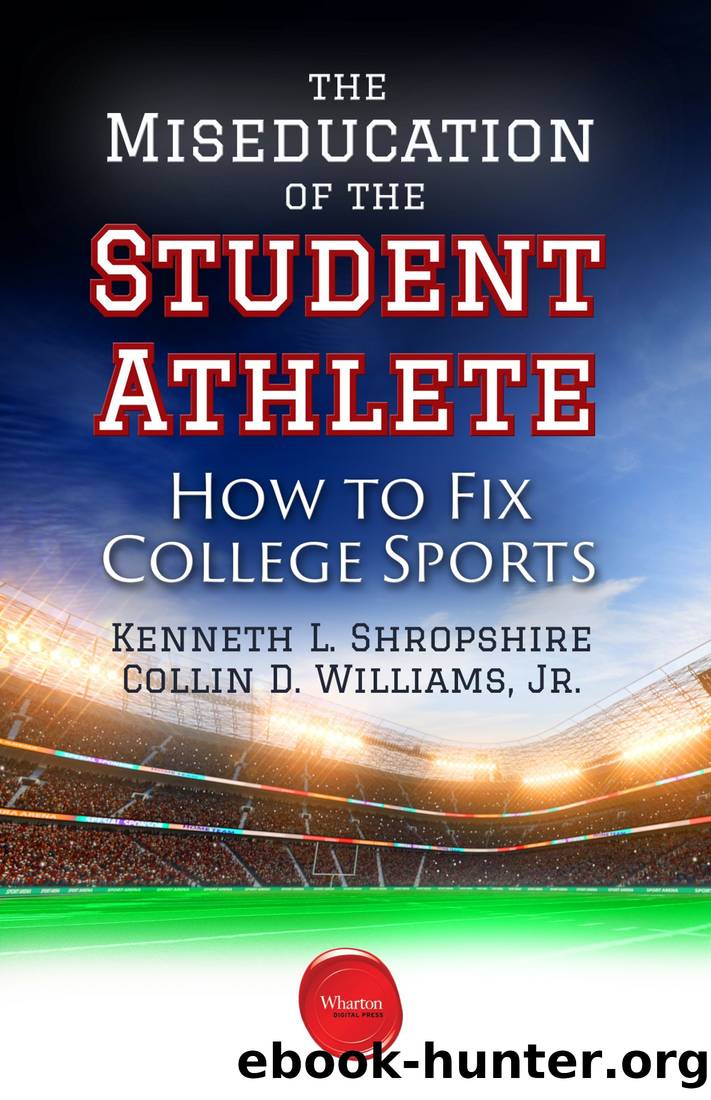The Miseducation of the Student Athlete: How to Fix College Sports by Kenneth L. Shropshire & Collin D. Williams

Author:Kenneth L. Shropshire & Collin D. Williams [Shropshire, Kenneth L. & Williams, Collin D.]
Language: eng
Format: epub
ISBN: 9781613630822
Amazon: 1613630824
Published: 2017-11-07T00:00:00+00:00
Chapter 4
The Solution: Constructive, Disruptive Systemic Change
You plan your day, your meals, and your study time around it. Everything is based on when I have practice next, what workout I have to be at, what is this going to do for my image as a football player, what kind of things am I going to be participating in, and how is it going to affect me as a football player. Itâs always football first, everything else is secondary. Friends can wait. Everything else can wait. You have your whole life to finish school, but you only get five years of eligibility.81
Regularly ranked among the top five public universities in the United States by U.S. News and World Report82 for its selective admissions, progressive financial-aid policies, and groundbreaking research, the University of North Carolina at Chapel Hill is also the home of one of the nationâs most storied basketball programs. The alma mater of Michael Jordan, arguably the greatest basketball player of all time, North Carolina boasts 20 Final Four appearances, 49 Atlantic Coast Conference championships, and 6 NCAA menâs basketball championships, the most recent in 2017.
However, since the 2014 season, the school has been under investigation for what Fox Sports has dubbed the âmost egregious academic fraud scandal in NCAA history.â83 Once touted as a pantheon of academic and athletic success, Chapel Hill has had its reputation muddied by an 18-year scandal in which students (predominantly student-athletes) were allegedly enrolled in fake âpaper classesâ in African- and Afro-American studies to boost their GPAs. Between 1993 and 2011, it is alleged that more than 3,100 students used those courses to maintain their eligibility and graduate.
The reality in sport is that there is always, unfortunately, someone or some enterprise willing to cheat. We do not delude ourselves in thinking that we could ever develop a system that would guarantee that the educational interest of student-athletes would always come first. From Deflategate in the NFL, to the junior tennis player lying about a line call, to performance-enhancing drugs across all sports, the willingness to violate rules for greater success seems to be never ending, and is very likely inevitable. So, we move with caution as we explore some changes that might make the situation better, understanding that there is in fact no ultimate panacea.
Chapter 4 explains how the model can best use increased revenues to benefit student-athletes. The chapter begins by exploring the relationship between sport, education, and opportunity. It then details the Student-Athlete Manifesto, laying out programs for athletes prior to their arrival on campus, during their time there, and after they leave their respective institutions, from preparatory and tutorial programs to funds for the return to college after their attempts at professional careers. We conclude on a cautionary note, addressing the need for academic oversight and external accountability.
Sport, Education, and Opportunity
The student-athlete compensation reform debate is bigger than sports. Since the 1946 Sanity Code legislation allowing athletes to access higher education in exchange for their athletic talents, competitive college sports have become an additional avenue through which the American Dream can be pursued.
Download
This site does not store any files on its server. We only index and link to content provided by other sites. Please contact the content providers to delete copyright contents if any and email us, we'll remove relevant links or contents immediately.
The Data Detective by Tim Harford(948)
Mind Management, Not Time Management by David Kadavy(617)
100 Tricks to Appear Smart in Meetings by Sarah Cooper(600)
GMAT For Dummies 2021 by Lisa Zimmer Hatch & Scott A. Hatch(586)
Amazing Decisions by Dan Ariely(489)
The Smart Strategy Book by Kevin Duncan(433)
The Data Science Framework by Unknown(416)
99 Financial Terms Every Beginner, Entrepreneur & Business Should Know (Financial IQ Series Book 1) by Herold Thomas(397)
The Store Detective Training Manual: A Practical Reference for Current and Aspiring Loss Prevention Officers by Glen Canarte(371)
Poor Students, Rich Teaching by Eric Jensen(332)
Robert's Rules of Order by Henry M. Robert(331)
Side Hustles: How to Make Extra Money Online by Hayden Vernon(307)
Arts, Sciences, and Economics by Tönu Puu(305)
97 Things Every Information Security Professional Should Know by Christina Morillo(304)
Cambridge IGCSE and O Level Business Studies by Karen Borrington(297)
Sustainable Education and Development by Unknown(295)
Excel 2016 for Marketing Statistics by Thomas J. Quirk & Eric Rhiney(292)
Enterprise Analytics by Thomas H. Davenport(288)
Information Literacy in Higher Education by unknow(279)
